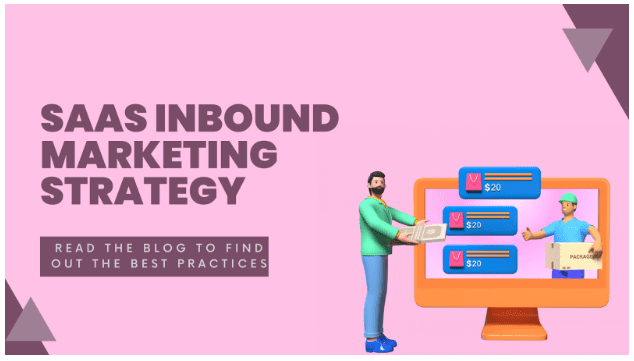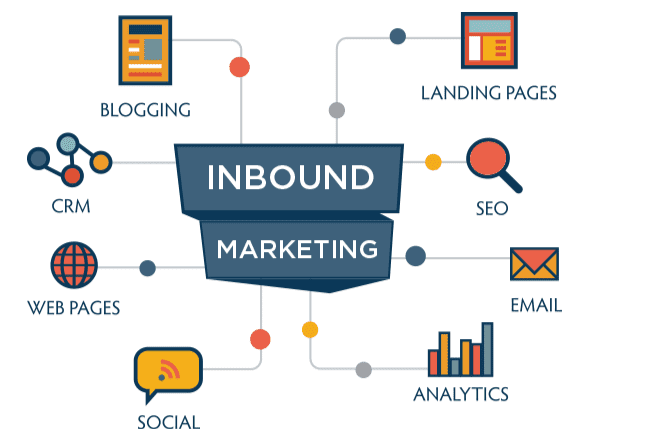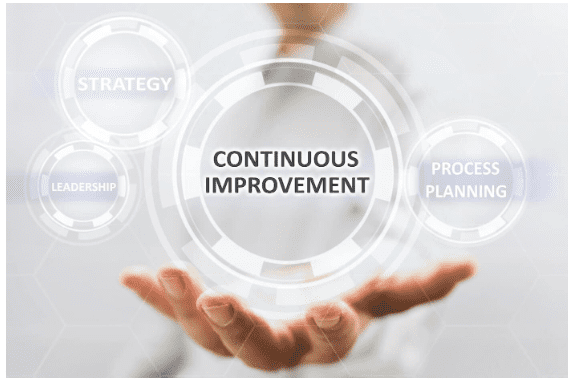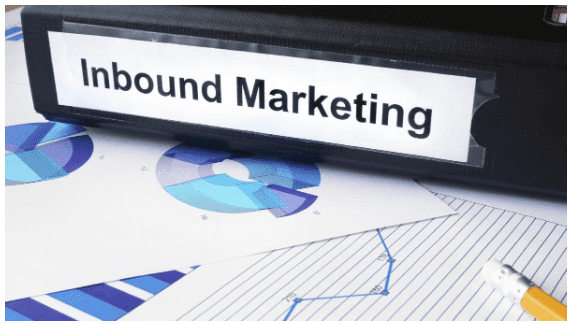Table of Contents
Toggle
Are you struggling to drive growth for your SaaS company?
Have you exhausted all traditional marketing tactics to no avail?
Inbound marketing may be the answer you’ve been searching for.
With the right inbound marketing strategy, you can attract, engage, and convert high-quality leads into loyal customers. In fact, a recent study found that businesses that prioritize inbound marketing are 4 times more likely to be effective than those that don’t.
In this article, I’ll share 10 proven ways to drive growth with inbound marketing for your SaaS company, from creating valuable content to optimizing your website for conversions. Follow these tips and watch your business thrive.
Understanding Inbound Marketing
Inbound marketing is a customer-centric approach that aims to attract potential customers by providing them valuable content rather than interrupting them with traditional advertising. Inbound marketing seeks to attract, engage, and delight customers by providing them with relevant and helpful content at every stage of their buyer’s journey.
One of the critical benefits of inbound marketing is its cost-effectiveness. According to HubSpot, inbound marketing generates three times as many leads as traditional outbound marketing but costs 62% less per lead.
In addition, inbound marketing allows companies to build long-term relationships with customers by establishing trust and authority through content that educates, entertains, and solves their problems.
To succeed in inbound marketing, it is essential to understand your target audience, their pain points, and their needs. This requires careful research and segmentation so that you can create content that is personalized and relevant to each segment. It also requires a commitment to measuring and analyzing the performance of your inbound marketing efforts so that you can continually optimize and improve your strategy.
What is inbound marketing, and how it differs from other marketing activities
Inbound marketing is a customer-centric approach that aims to attract potential customers by providing them valuable content rather than interrupting them with traditional advertising. Inbounseeksrketing seeks to create a relationship with potential customers by providing them with relevant and helpful content at every stage of their buyer’s journey.
In contrast, other marketing activities, such as outbound marketing, focus on reaching out to potential customers with advertisements, cold-calling, and other interruption-based marketing. Outbound marketing is often seen as less effective than inbound marketing because it can be intrusive and may not resonate with the needs and interests of the target audience.
Inbound marketing differs from traditional marketing activities such as print ads, billboards, and TV commercials. Traditional marketing is typically more expensive and less targeted than inbound marketing and provides different opportunities for engagement and relationship-building.
Inbound marketing provides value to potential customers, builds trust and authority, and creates long-term relationships. By contrast, other marketing activities focus on reaching as many people as possible, regardless of whether they are interested in or likely to purchase the advertised product or service.
Importance of inbound marketing for SaaS companies
Inbound marketing is essential for SaaS companies because it is a customer-centric approach that aligns with the unique characteristics of the SaaS business model. SaaS products are often complex, and customers need to understand how they work, what benefits they offer, and how they can integrate with existing systems.
- Inbound marketing can help SaaS companies to achieve these goals by providing potential customers with valuable content that educates and informs them about the product. This content can include blog posts, white papers, case studies, and webinars.
- In addition, inbound marketing allows SaaS companies to target potential customers at every stage of the buyer’s journey, from awareness to consideration to decision-making. SaaS companies can nurture leads and build long-term customer relationships by providing relevant content at each location.
- Another critical benefit of inbound marketing for SaaS companies is its cost-effectiveness. Unlike traditional marketing channels such as TV ads and billboards, inbound marketing can be highly targeted and personalized, allowing companies to reach potential customers with greater precision and at a lower cost.
Inbound marketing is a powerful tool for SaaS companies that want to build brand awareness, generate leads, and build long-term customer relationships.
By providing valuable content and engaging with potential customers at every stage of the buyer’s journey, SaaS companies can differentiate themselves from competitors and achieve sustainable growth over the long term.

Key Components of Inbound Marketing
Inbound marketing consists of several key components, each essential in attracting potential customers, engaging them, and building long-term relationships. The main features of inbound marketing include the following:
- Content Marketing: This involves creating and sharing valuable content, such as blog posts, e-books, and videos, designed to attract potential customers and provide them with helpful information.
- Search Engine Optimization (SEO): This involves optimizing your website and content to rank higher in search engine results pages, making it easier for potential customers to find you.
- Social Media Marketing: This involves leveraging social media platforms like Facebook, Twitter, and LinkedIn to promote your content, engage with potential customers, and build your brand.
- Email Marketing: This involves using email to communicate with potential customers, provide them with helpful information, and nurture leads over time.
- Marketing Automation: This involves using software tools to automate repetitive marketing tasks, such as lead nurturing, email campaigns, and social media scheduling.
- Analytics and Reporting: This involves tracking and analyzing the performance of your inbound marketing efforts so that you can continually optimize and improve your strategy.
By combining these components into a cohesive inbound marketing strategy, businesses can attract potential customers, educate them about their products or services, and ultimately convert them into paying customers. The key to success is to create valuable content, personalize your messaging, and continually optimize your strategy based on data and insights.
Key components of effective inbound marketing
Effective inbound marketing requires a strategic and integrated approach incorporating several vital components. The main features of effective inbound marketing include the following:
- Understanding Your Target Audience: This involves identifying your target audience, their needs, and their pain points so that you can create content that resonates with them and addresses their specific challenges.
- Compelling Content Creation: This involves creating high-quality, valuable content that educates, entertains, and informs your target audience. This content can take many forms, including blog posts, videos, infographics, case studies, and whitepapers.
- Search Engine Optimization (SEO): This involves optimizing your website and content to rank higher in search engine results pages, making it easier for potential customers to find you when they search for relevant keywords and phrases.
- Social Media Engagement: This involves leveraging social media platforms like Facebook, Twitter, LinkedIn, and Instagram to promote your content, engage with your target audience, and build your brand.
- Lead Nurturing: This involves developing a strategy to nurture leads over time, using tactics such as email marketing, personalized messaging, and marketing automation to stay in mind with potential customers and move them closer to a purchase decision.
- Analytics and Reporting: This involves tracking and analyzing the performance of your inbound marketing efforts to identify what is working well, what needs improvement, and where you should focus your resources going forward.
By focusing on these critical components, businesses can create a comprehensive and effective inbound marketing strategy that attracts potential customers, builds trust and credibility, and ultimately drives revenue growth.
Content marketing, SEO, social media, and lead generation
Content marketing, SEO, social media, and lead generation are four critical components of an effective inbound marketing strategy. Each member plays a vital role in attracting potential customers, engaging them, and ultimately converting them into paying customers.
- Content marketing involves creating valuable, informative content that attracts and engages potential customers. This content can take many forms, including blog posts, e-books, whitepapers, videos, infographics, and more. By providing helpful information and addressing the pain points of your target audience, you can establish your brand as a trusted authority and build long-term relationships with potential customers.
- Search engine optimization (SEO) involves optimizing your website and content to rank higher in search engine results pages. This includes targeting relevant keywords, creating high-quality content, optimizing metadata and tags, and building high-quality backlinks to your website. By ranking higher in search engine results pages, you can increase your visibility to potential customers and drive more traffic to your website.
- Social media marketing involves leveraging social media platforms such as Facebook, Twitter, LinkedIn, and Instagram to promote your content, engage with your target audience, and build your brand. Creating engaging content and interacting with your followers can make a loyal following and establish a solid online presence.
- Lead generation involves developing a strategy to capture and nurture leads over time. This includes creating compelling offers such as e-books, whitepapers, and webinars, designing landing pages and forms to capture leads, and using email marketing and marketing automation to nurture leads over time. By providing value to potential customers and staying top of mind, you can build trust and credibility and ultimately convert more leads into paying customers.
By integrating these four components into a comprehensive inbound marketing strategy, businesses can attract potential customers, build brand awareness, and drive revenue growth over the long term.

Importance of Customer Research
Customer research is a critical component of any effective inbound marketing strategy. By understanding your target audience’s needs, wants, and pain points, you can create content that resonates with them and provides real value.
- One of the key benefits of customer research is that it allows you to create a more personalized and targeted marketing message. By understanding your customers’ preferences and behaviors, you can create content that speaks directly to them and addresses their specific challenges. This can help you to build a stronger connection with your target audience and establish your brand as a trusted authority in your industry.
- Customer research can also help you identify new growth and innovation opportunities. By understanding your customers’ needs and pain points, you can identify gaps in the market and develop new products or services that meet those needs. This can help you to stay ahead of the competition and drive long-term growth and profitability.
- Another benefit of customer research is that it can help you to improve your overall customer experience. You can identify areas to improve your products, services, and customer support by soliciting customer feedback and insights. This can help you build a reputation for quality and reliability and create loyal customers who are more likely to recommend your brand to others.
Customer research is essential for any business to succeed in today’s competitive marketplace. Understanding your customers’ needs wants, and preferences can create more effective marketing messages, identify new growth opportunities, and improve the overall customer experience.
Conducting customer research to identify target audience needs and pain points.
Customer research is essential for identifying your target audience’s needs and pain points. There are several methods you can use to conduct customer research, including:
- Surveys: Surveys are a popular way to gather feedback from customers. Surveys can provide valuable insights into customer needs, pain points, and satisfaction levels. You can use online survey tools to create and distribute surveys to your target audience.
- Interviews: Interviews allow you to have more in-depth conversations with customers and can be especially useful for identifying customer pain points. You can interview in person, over the phone, or via video conferencing.
- Social media listening: Social media listening involves monitoring social media platforms for mentions of your brand or industry. This can help you identify common customer complaints or issues, trends, and opportunities.
- Website analytics: Website analytics can provide valuable insights into customer behavior, such as which pages are most popular and where customers are dropping off in the sales funnel. This information can help you to optimize your website and marketing messages.
When conducting customer research, it is essential to keep an open mind and be willing to listen to feedback, even if it is negative. You should also look for patterns and trends in the feedback you receive rather than focusing on individual comments.
By conducting thorough customer research, you can identify your target audience’s needs and pain points and create content and marketing messages that address those needs and pain points. This can help you to build a stronger connection with your target audience and establish your brand as a trusted authority in your industry.
Utilizing customer research to inform inbound marketing strategies
Customer research can be a powerful tool for informing your inbound marketing strategies. Understanding your target audience’s needs and pain points can create more targeted and effective marketing messages that resonate with potential customers. Here are some ways that you can use customer research to inform your inbound marketing strategies:
- Develop buyer personas: Buyer personas are fictional representations of your target audience based on research and data. By creating buyer personas, you can identify your target audience’s specific needs, behaviors, and pain points and create content that addresses those needs and pain points.
- Create targeted content: Once you have developed buyer personas, you can use that information to create targeted content that speaks directly to your target audience. This content can take many forms, including blog posts, e-books, whitepapers, videos, and more.
- Optimize your website for search engines: Customer research can also help you identify the keywords and phrases your target audience is searching for. Optimizing your website and content for those keywords improves your search engine rankings and attracts more potential customers.
- Engage with your target audience on social media: Social media platforms provide a valuable opportunity to engage with your target audience and build relationships with potential customers. By understanding the interests and behaviors of your target audience, you can create social media content that is more likely to resonate with them and encourage engagement.
- Develop lead nurturing strategies: Customer research can also help you identify the specific pain points and challenges potential customers face. By developing lead nurturing strategies that address those challenges, you can build trust with potential customers and move them closer to a purchase decision.
Customer research is a critical component of effective inbound marketing. Using customer insights to inform your marketing strategies, you can create more targeted and effective marketing messages that resonate with your target audience and drive business growth.

Lead Generation Strategy for Effective Inbound Marketing
Lead generation is a critical component of effective inbound marketing, as it involves identifying and nurturing potential customers who have expressed interest in your product or service. Here are some essential steps to developing a lead generation strategy for effective inbound marketing:
- Develop buyer personas: Develop detailed buyer personas that represent your target audience. This will help you understand your potential customer’s needs, behaviors, and pain points.
- Create compelling offers: Develop high-quality, valuable content that addresses your target audience’s needs and pain points. This can take many forms, including e-books, whitepapers, webinars, and more.
- Use landing pages and forms: Use landing pages and forms to capture contact information from potential customers interested in your offers. Ensure your landing pages are well-designed and optimized for conversions, and keep your documents short and easy to complete.
- Leverage email marketing: Use email marketing to nurture leads over time, providing them with additional valuable content and information. Make sure your emails are personalized and relevant to each lead, and use marketing automation tools to streamline the process.
- Use social media: Leverage social media platforms to promote your offers and engage with potential customers. Use social media listening tools to monitor conversations and identify opportunities to engage with potential customers.
- Measure and optimize: Use analytics tools to measure the performance of your lead generation efforts and continually optimize your strategy based on the data. Test different offers, landing pages, and forms to see what works best for your target audience.
By following these steps, you can develop an effective lead generation strategy that attracts potential customers, nurtures them over time, and ultimately drives revenue growth for your business.
Developing a lead generation strategy that aligns with your target audience and product positioning
Developing a lead generation strategy that aligns with your target audience and product positioning is essential for effective inbound marketing. Here are some critical steps to creating a lead generation strategy that is tailored to your target audience and product positioning:
- Identify your target audience: Understand their needs, behaviors, and pain points. This will help you to create offers and messaging that resonate with them.
- Define your product positioning: Clearly define your product positioning, including your unique value proposition and key differentiators. This will help you to develop messaging that highlights the benefits of your product and sets you apart from competitors.
- Create compelling offers: Develop offers that align with your target audience and product positioning. This could include e-books, whitepapers, webinars, or other forms of content that provide value to potential customers.
- Develop landing pages and forms: Use landing pages and documents to capture contact information from potential customers interested in your offers. Ensure your landing pages are well-designed and optimized for conversions, and keep your forms short and easy to complete.
- Use targeted messaging: Develop messaging that speaks directly to your target audience and highlights the benefits of your product. This messaging should be consistent across all your marketing channels, including email, social media, and paid advertising.
- Leverage social media: Use social media platforms to promote your offers and engage with potential customers. Use social media listening tools to monitor conversations and identify opportunities to engage with potential customers.
- Measure and optimize: Use analytics tools to measure the performance of your lead generation efforts and continually optimize your strategy based on the data. Test different offers, landing pages, and messaging to see what works best for your target audience and product positioning.
By following these steps, you can develop a lead generation strategy tailored to your target audience and product positioning, driving revenue growth for your business.
Utilizing landing pages, forms, and calls-to-action to generate leads
Landing pages, forms, and calls-to-action (CTAs) are essential for an effective lead-generation strategy. Here are some tips for using these tools to generate leads:
- Landing pages: Landing pages are standalone pages on your website designed to capture potential customers’ contact information. To be effective, landing pages should be well-designed, visually appealing, and optimized for conversions. They should also be tailored to a specific offer or campaign and contain a clear and compelling value proposition.
- Forms: Forms are used on landing pages to collect contact information from potential customers. To maximize conversions, arrangements should be simple and easy to complete and should only ask for data essential to your lead generation efforts. You can also use progressive profiling to collect more information from leads over time gradually.
- Calls-to-action (CTAs): CTAs encourage potential customers to take a specific action, such as downloading an e-book or signing up for a webinar. To be effective, CTAs should be eye-catching and prominently displayed on your website and landing pages. They should also be tailored to your target audience and product positioning and should communicate the benefits of taking the desired action.
When using landing pages, forms, and CTAs to generate leads, continually testing and optimizing your strategy is essential. Try different variations of your landing pages, documents, and CTAs to see what works best for your target audience and product positioning. Use analytics tools to measure the performance of your lead generation efforts and make data-driven decisions to improve your strategy over time.
Using landing pages, forms, and CTAs effectively can generate high-quality leads for your business and drive revenue growth over the long term.

Ten ways to drive growth for Saas companies with inbound marketing strategy
Here are 10 ways to drive growth for SaaS companies with an inbound marketing strategy:
- Develop targeted buyer personas: Develop detailed buyer personas that represent your target audience, and use them to create content and marketing messages that address their specific needs and pain points.
- Create high-quality, valuable content: Develop a content marketing strategy that includes blog posts, e-books, whitepapers, and other forms of content that provide real value to your target audience.
- Optimize your website for search engines: Use search engine optimization (SEO) techniques to improve your website’s rankings and attract more potential customers.
- Use social media to promote your content: Use social media platforms to nurture and engage with potential customers. Be sure to tailor your messaging and content to your specific social media platform.
- Leverage email marketing to nurture leads: Use email marketing to stay in touch with potential customers and provide them with additional valuable content over time.
- Develop effective lead nurturing strategies: Develop a lead nurturing strategy that addresses your target audience’s specific needs and pain points, using tactics such as personalized messaging and marketing automation.
- Use analytics to measure performance: Use analytics tools to measure the performance of your inbound marketing efforts and make data-driven decisions to optimize your strategy over time.
- Create compelling offers: Develop exciting offers such as e-books, whitepapers, and webinars to capture the contact information of potential customers.
- Utilize paid advertising: Use paid advertising platforms such as Google Ads and social media ads to reach a larger audience and drive traffic to your website.
- Test and optimize your strategy: Test different content variations, messaging, and offers to see what works best for your target audience and product positioning.
By implementing these ten strategies, SaaS companies can drive growth, attract potential customers, and ultimately drive revenue growth over the long term.
Measuring Success and Refining Your Strategy
Measuring the success of your inbound marketing strategy is essential for refining and improving your approach over time. Here are some key metrics to track when measuring the success of your inbound marketing efforts:
- Website traffic: Monitor the number of visitors to your website and the sources of that traffic to see which marketing channels drive the most traffic.
- Conversion rates: Measure the percentage of website visitors who convert into leads or customers. This can help you to identify areas where you may need to improve your website or marketing messaging.
- Lead quality: Evaluate the quality of your information by looking at factors such as the number of leaders who become paying customers and the length of the sales cycle.
- Sales revenue: Track your income over time to see how your inbound marketing efforts impact your bottom line.
- Customer lifetime value (CLV): Calculate the CLV of your customers to see how much weight they bring to your business over time.
- Return on investment (ROI): Calculate the ROI of your inbound marketing efforts by comparing the costs of your marketing activities to the revenue they generate.
When measuring the success of your inbound marketing efforts, it’s essential to use data-driven insights to refine and improve your strategy over time. Continually test different variations of your content, messaging, and offers to see what works best for your target audience and product positioning.
By monitoring these key metrics and using data-driven insights to refine your strategy, you can continually improve the effectiveness of your inbound marketing efforts and drive long-term growth for your SaaS company.

Key Performance Indicators (KPIs)
Key Performance Indicators (KPIs) are metrics used to measure the success of a specific business goal or objective. When it comes to inbound marketing, several KPIs can help you to evaluate the effectiveness of your efforts. Here are some key KPIs to track when measuring the success of your inbound marketing strategy:
- Website traffic: Track the number of visitors to your website over time and the sources of that traffic. This can help you identify which marketing channels drive the most traffic to your website.
- Conversion rates: Measure the percentage of website visitors who convert into leads or customers. This can help you to identify areas where you may need to improve your website or marketing messaging.
- Cost per lead (CPL): Calculate the price per lead by dividing the total cost of your marketing efforts by the number of leads generated. This can help you to determine the ROI of your inbound marketing efforts.
- Customer acquisition cost (CAC): Calculate the cost of acquiring a new customer by dividing your total marketing and sales expenses by the number of new customers. This can help you to determine the profitability of your inbound marketing efforts.
- Sales revenue: Track your income over time to see how your inbound marketing efforts impact your bottom line.
- Customer lifetime value (CLV): Calculate the CLV of your customers to see how much weight they bring to your business over time.
- Return on investment (ROI): Calculate the ROI of your inbound marketing efforts by comparing the costs of your marketing activities to the revenue they generate.
By monitoring these KPIs and using data-driven insights to refine your strategy, you can continually improve the effectiveness of your inbound marketing efforts and drive long-term growth for your business.
Defining KPIs to measure the success of your inbound marketing strategy
Defining Key Performance Indicators (KPIs) to measure the success of your inbound marketing strategy requires careful consideration of your business goals and objectives. Here are some steps to help you define KPIs for your inbound marketing strategy:
- Identify your business goals: Start by identifying the business goals you want to achieve through your inbound marketing efforts. These goals include increasing website traffic, generating leads, or driving sales revenue.
- Align your KPIs with your business goals: Once you have identified your business goals, define KPIs that align with those goals. For example, if your goal is to increase website traffic, your KPI might be website traffic or bounce rate.
- Define specific metrics for each KPI: For each KPI, define particular metrics that you will track to measure success. For example, if your KPI is website traffic, you might follow the number of unique visitors, pages viewed per visit, and the bounce rate.
- Set targets for each metric: Once you have defined specific metrics for each KPI, set targets for each. These targets should be clear, measurable, and aligned with your business goals.
- Continuously monitor and analyze your metrics: Continuously monitor and analyze your metrics to see how they are tracking against your targets. Use this data to make data-driven decisions and refine your inbound marketing strategy.
By defining KPIs that align with your business goals and tracking specific metrics, you can measure the success of your inbound marketing efforts and make data-driven decisions to improve your strategy over time.
Tracking and analyzing KPIs regularly
Tracking and analyzing Key Performance Indicators (KPIs) regularly is essential to measuring the success of your inbound marketing strategy and making data-driven decisions to improve your approach over time. Here are some tips for tracking and analyzing KPIs regularly:
- Set up a dashboard: Set up a dashboard that displays your most important KPIs, such as website traffic, conversion rates, and cost per lead. This will help you to monitor your KPIs at a glance and identify any trends or issues.
- Use analytics tools: Use tools like Google Analytics to track your KPIs over time. These tools can help you identify which marketing channels drive the most traffic and conversions and how visitors engage with your website.
- Monitor your KPIs regularly: Set a schedule for monitoring your KPIs regularly, such as daily, weekly, or monthly. This will help you to identify any changes or trends over time.
- Analyze your data: Use your analytics tools to analyze your data and identify trends and patterns. Look for areas where you see improvement and where you may need to change your strategy.
- Make data-driven decisions: Use the data you gather to make data-driven decisions about your inbound marketing strategy. For example, if you notice that a particular marketing channel is not generating leads, you may need to shift your system to focus on other media.
By tracking and analyzing your KPIs regularly, you can identify areas for improvement and make data-driven decisions to improve the effectiveness of your inbound marketing strategy over time.

Continuous Improvement
Continuous improvement is essential for the long-term success of your inbound marketing strategy. Here are some critical steps for continuously improving your inbound marketing efforts:
- Analyze your data: Use analytics tools to analyze your data and identify trends and patterns. Look for areas where you see improvement and where you may need to change your strategy.
- Test and optimize your approach: Continually test different variations of your content, messaging, and offers to see what works best for your target audience and product positioning. Use A/B testing to compare different variations and make data-driven decisions.
- Incorporate feedback from customers and prospects: Listen to feedback from your customers and prospects and use it to refine your approach over time. This feedback can help you to identify areas where you may need to improve your messaging, content, or offers.
- Stay up-to-date with industry trends: Stay up-to-date with industry trends and best practices, and incorporate them into your strategy where appropriate. Attend industry events, read blogs and whitepapers, and stay active in online communities to stay current with the latest trends and innovations.
- Collaborate with other teams: Collaborate with other teams within your organization, such as sales and customer service, to gain insights and perspectives that inform your inbound marketing strategy. This collaboration can help you to identify new opportunities and better understand your target audience.
By continuously analyzing your data, testing and optimizing your approach, incorporating feedback, staying up-to-date with industry trends, and collaborating with other teams, you can constantly improve the effectiveness of your inbound marketing strategy and drive long-term growth for your business.
Continually assessing and refine your inbound marketing strategy based on performance data and customer feedback.
Continually assessing and refining your inbound marketing strategy based on performance data and customer feedback is essential for the long-term success of your business. Here are some steps to help you assess and refine your inbound marketing strategy:
- Review your performance data: Use analytics tools to review your performance data and identify areas for improvement. Look for trends and patterns, such as which marketing channels drive the most traffic and conversions and which content resonates with your target audience.
- Gather customer feedback: Gather feedback from your customers and prospects through surveys, focus groups, and social media. Use this feedback to gain insights into their needs, pain points, and preferences, and use it to inform your inbound marketing strategy.
- Evaluate your buyer personas: Regularly evaluate them to ensure they accurately reflect your target audience. Make updates to your personas as needed based on feedback and performance data.
- Test and refine your messaging: Continuously test and refine your messaging to ensure it resonates with your target audience. Use A/B testing to compare different variations and make data-driven decisions.
- Experiment with new marketing channels: Experiment with new marketing channels to see if they can help you to reach new audiences and generate more leads. Examples of new tracks you could explore include podcast advertising, influencer marketing, and chatbots.
- Collaborate with other teams: Collaborate with other teams within your organization, such as sales and customer service, to gain insights and perspectives that inform your inbound marketing strategy. This collaboration can help you to identify new opportunities and better understand your target audience.
By continually assessing and refining your inbound marketing strategy based on performance data and customer feedback, you can improve the effectiveness of your approach over time and drive long-term growth for your business.
Making data-driven decisions to optimize and refine your approach
Making data-driven decisions to optimize and refine your approach is essential for the success of your inbound marketing strategy. Here are some steps to help you make data-driven decisions:
- Set clear goals: Set clear goals for your inbound marketing strategy, such as increasing website traffic, generating more leads, or driving sales revenue. These goals should be specific, measurable, and aligned with your business objectives.
- Define KPIs: Define Key Performance Indicators (KPIs) that align with your goals and track specific metrics to measure success. This will help you monitor your inbound marketing strategy’s effectiveness and identify improvement areas.
- Use analytics tools: Use tools like Google Analytics to track your KPIs and analyze your data. Look for trends and patterns that can help you to optimize and refine your approach.
- Test and optimize: Continuously test and optimize different variations of your content, messaging, and offers to see what works best for your target audience and product positioning. Use A/B testing to compare different variations and make data-driven decisions.
- Incorporate feedback: Listen to feedback from your customers and prospects and use it to refine your approach over time. This feedback can help you to identify areas where you may need to improve your messaging, content, or offers.
- Collaborate with other teams: Collaborate with other teams within your organization, such as sales and customer service, to gain insights and perspectives that inform your inbound marketing strategy. This collaboration can help you to identify new opportunities and better understand your target audience.
By setting clear goals, defining KPIs, using analytics tools, testing and optimizing, incorporating feedback, and collaborating with other teams, you can make data-driven decisions that will help you to optimize and refine your inbound marketing approach over time.

Conclusion
Final thoughts and recommendations
Inbound marketing is a powerful approach to driving long-term growth for SaaS companies. You can attract, engage, and delight your ideal customers by providing valuable content and engaging with your target audience on their terms.
Developing a clear strategy that aligns with your business goals and target audience needs is essential to succeed with inbound marketing. This strategy should include critical components such as content marketing, SEO, social media, lead generation, and continuous assessment and refinement based on performance data and customer feedback.
When implementing your inbound marketing strategy, define clear KPIs and use analytics tools to track your progress over time. Use data-driven insights to refine and optimize your approach, and don’t be afraid to experiment with new marketing channels and tactics to see what works best for your business.
Finally, remember that inbound marketing is a long-term game; seeing results takes time and effort. Stay committed to your strategy and be patient; you will see the benefits of inbound marketing for your SaaS company over time.
FAQs
What is inbound marketing for SaaS companies?
Inbound marketing focuses on attracting, engaging, and delighting your target audience by providing valuable content and experiences that align with their needs and interests. Inbound marketing is a highly effective approach for SaaS companies to drive long-term growth by building a loyal customer base and generating recurring revenue.
Inbound marketing for SaaS companies involves creating and sharing valuable content such as blog posts, ebooks, webinars, and whitepapers that educate and inform your target audience about your product and industry. It also involves leveraging SEO to optimize your content for search engines and social media to engage with your audience on platforms where they spend time.
Inbound marketing for SaaS companies also includes lead generation strategies such as landing pages, forms, and calls-to-action to capture contact information from potential customers, as well as email marketing and lead nurturing campaigns to build relationships with leads over time.
SaaS companies can build brand awareness, generate high-quality leads, and increase customer loyalty and retention by adopting an inbound marketing approach.
Why is practical inbound marketing essential for driving growth?
Effective inbound marketing is essential for driving growth for several reasons:
- Attracts ideal customers: Inbound marketing is designed to attract and engage with your ideal customers, who are more likely to become long-term, loyal customers. By providing valuable content and experiences that align with their needs and interests, you can build trust and credibility with your target audience and position your product as a solution to their pain points.
- Generates high-quality leads: Inbound marketing generates high-quality leads that are more likely to convert into customers. Using lead magnets, landing pages, forms, and calls to action, you can capture contact information from potential customers who are interested in your product and ready to learn more.
- Builds brand awareness: Inbound marketing helps create and share valuable content that educates and informs your target audience about your product and industry. By establishing your brand as a thought leader in your industry, you can increase your visibility and attract more potential customers to your website.
- Increases customer retention: Inbound marketing helps to increase customer retention by providing lasting value and support to your existing customers. By providing educational resources, engaging content, and exceptional customer service, you can build strong relationships with your customers and encourage them to remain loyal to your brand over time.
- Provides measurable results: Inbound marketing provides measurable results that allow you to track your progress and optimize your approach over time. By defining clear KPIs and using analytics tools to track your progress, you can make data-driven decisions that improve the effectiveness of your inbound marketing strategy and drive long-term growth for your business.
Effective inbound marketing is essential for driving growth for SaaS companies by attracting ideal customers, generating high-quality leads, building brand awareness, increasing customer retention, and providing measurable results that allow you to optimize and refine your approach over time.

What are the critical components of effective inbound marketing?
The critical components of effective inbound marketing include:
- Content marketing: Creating valuable, informative content that addresses your target audience’s needs and interests. Content marketing can include blog posts, ebooks, webinars, podcasts, and more.
- Search engine optimization (SEO): Optimizing your website and content to rank higher in search engine results pages and attract more organic traffic.
- Social media marketing: Engaging with your target audience on social media platforms, sharing your content, and building relationships with potential customers.
- Lead generation: Creating landing pages, forms, and calls to action to capture contact information from potential customers and generate leads.
- Email marketing: Building relationships with leads and customers by sending targeted, personalized emails that provide value and encourage engagement.
- Lead nurturing: Providing ongoing education and support to leads through targeted content and messaging to build trust and encourage customer conversion.
- Customer service: Providing exceptional customer service and support to build long-term loyalty and retention.
By incorporating these key components into your inbound marketing strategy, you can attract, engage, and delight your target audience and drive long-term growth for your SaaS company.
What strategies can you use for effective inbound marketing?
There are several strategies that you can use for effective inbound marketing:
- Develop buyer personas: Develop detailed buyer personas that accurately reflect your target audience’s needs, interests, and pain points. These personas inform your content marketing, SEO, and social media strategies.
- Conduct keyword research: Conduct keyword research to identify the keywords and phrases your target audience uses to search for information related to your product or service. Use these keywords to optimize your website and content for search engines.
- Create high-quality content: Create high-quality, informative content that addresses your target audience’s needs and interests. This content can include blog posts, ebooks, webinars, podcasts, and more.
- Leverage social media: Leverage social media platforms such as Facebook, Twitter, and LinkedIn to engage with your target audience, share your content, and build relationships with potential customers.
- Use landing pages and calls-to-action: Use landing pages and calls-to-action to capture contact information from potential customers and generate leads.
- Nurture leads with email marketing: Nurture leads with targeted, personalized emails that provide ongoing education and support and encourage customer conversion.
- Provide exceptional customer service: To build long-term loyalty and retention, provide excellent customer service and support.
Using effective inbound marketing strategies, you can attract, engage, and delight your target audience, generate high-quality leads, and drive long-term growth for your SaaS company.
How do you measure success and continuously improve your inbound marketing strategy?
To measure success and continuously improve your inbound marketing strategy, you can take the following steps:
- Define clear goals and KPIs: Define clear goals and Key Performance Indicators (KPIs) that align with your overall business objectives, such as increasing website traffic, generating more leads, or driving sales revenue.
- Use analytics tools: Use tools like Google Analytics to track your KPIs and analyze your data. Look for trends and patterns that can help you to optimize and refine your approach.
- Conduct A/B testing: Continuously test different variations of your content, messaging, and offers to see what works best for your target audience and product positioning. Use A/B testing to compare different variations and make data-driven decisions.
- Incorporate feedback: Listen to feedback from your customers and prospects and use it to refine your approach over time. This feedback can help you to identify areas where you may need to improve your messaging, content, or offers.
- Stay up-to-date with industry trends: Stay up-to-date with industry trends and best practices, and incorporate them into your strategy where appropriate. Attend industry events, read blogs and whitepapers, and stay active in online communities to stay current with the latest trends and innovations.
- Collaborate with other teams: Collaborate with other teams within your organization, such as sales and customer service, to gain insights and perspectives that inform your inbound marketing strategy. This collaboration can help you to identify new opportunities and better understand your target audience.
By defining clear goals and KPIs, using analytics tools, conducting A/B testing, incorporating feedback, staying up-to-date with industry trends, and collaborating with other teams, you can measure success and continuously improve your inbound marketing strategy over time.
- Success vs. Significance: Understanding the Difference and Achieving Both - October 1, 2023
- 8 Steps to SaaS Success: From Idea to Business - September 30, 2023
- The Importance of Testing in SaaS: Ensure Quality and Success - September 29, 2023